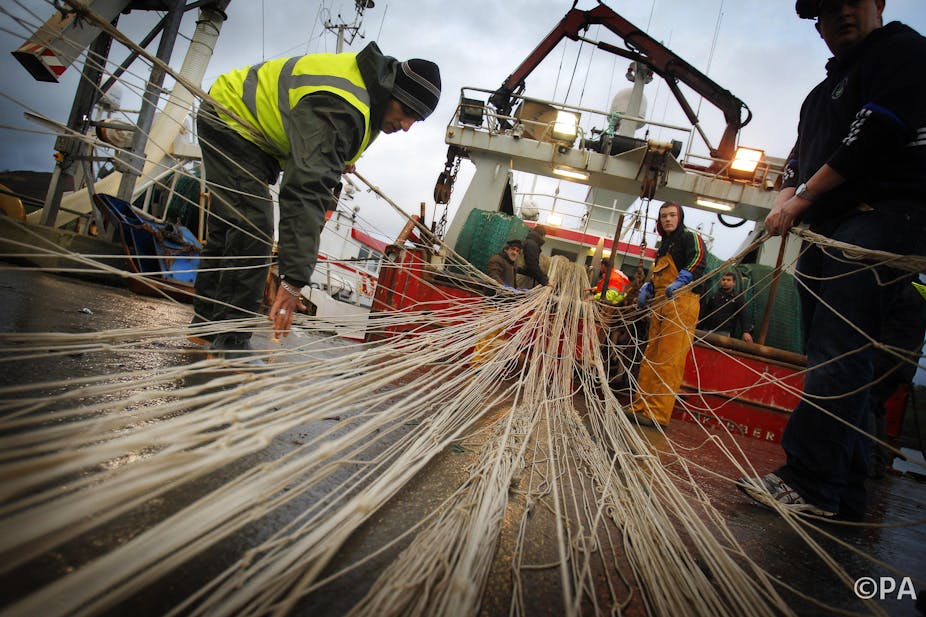Bottom trawling by fishing fleets has caused widespread concern over the environmental damage done to seabed habitats and marine life. It seems obvious that powerful boats towing large heavy nets that strip off the caps of sea mounts and tear away long-established reefs create environmental devastation from which recovery may take centuries.
This has resulted in EU initiatives to curb or ban bottom trawling in order to protect vulnerable marine ecosystems, but also to maintain vital fish stocks necessary for our food supply. The ban proposed in 2012 would phase out bottom trawling for deep-sea species in the northeast Atlantic Ocean.
However, in shallow seas on the continental shelves, where the sea floor is made up of shifting sands and gravels that are regularly stirred up by winter storms, the effects of trawling may be benign, or even beneficial.
On land it is well known that thinning of forest trees, rolling of grassy swards or burning of upland heather can create opportunities for new shoots to grow and increase productivity. Perhaps ploughing up the sea floor by trawl could have a similar effect?
In 1996 Adriaan Rijnsdorp and PI van Leeuwen first proposed that increased quantities of plaice in the southern North Sea from the 1960s onwards could be partially explained by the beneficial effects of Dutch beam trawlers stirring up the sea floor. This triggered a debate as to whether the effect is real, and what might be the possible explanation.
One idea is that trawling damages large hard-bodied bottom-living animals such as molluscs and crustaceans, allowing growth of smaller soft-bodied animals such as polychaete worms, which are much more palatable for fish. Trawling thus causes a shift in those animals on the seabed towards fish food species, and hence stimulates growth of fishes. It can argued that beam trawlers are actually improving the sea floor in the same way that terrestrial farmers improve the grazing for cattle by raking and rolling the ground.
In a paper published this week, Adriaan Rijnsdorp, senior author Daniel van Denderen and Tobias van Kooten have produced a mathematical model of the effect trawling has on the southern North Sea ecosystem. The model indeed shows that trawling can increase fish production.
But it can also have the opposite effect. In the southern North Sea, despite some areas being trawled over more than once per year, total destruction of habitat is not thought to take place, but rather subtle modification of how the ecosystem works to produce different outcomes. This detail is what the model reveals.
The model is based on the presence of two hypothetical organisms fed on by fish. One is vulnerable to trawling, and the other resistant. Two alternative scenarios are tested. In one, prey abundance is “top down” controlled by fish predation, and in the other it is “bottom up” controlled by environmental effects.
The relative palatability of the two types of prey was also adjusted. What is revealed is that modifying the sea floor’s ecosystem can increase fish numbers and provide higher yields to fishers as the intensity of trawling increases. So the model predicts that efforts to reduce the impacts of trawling by modifying the equipment or banning it may paradoxically reduce fish populations and fishing yields. However, the outcome depends on the initial conditions, and trawling can create the opposite effects if the prey vulnerable to trawling are those most eaten by fishes. Overall, the study demonstrates support for the hypothesis in the original 1996 paper.
This new paper is a very important contribution to the bottom-trawling debate. There is no doubt that trawling in pristine deep-sea habitats can be highly damaging, but areas such as the southern North Sea have been subjected to beam trawling for at least 600 years. Steam-powered trawlers from the 1890s and intensified fishing since the 1960s has created what could probably be regarded as a cultivated seascape that favours flatfishes such as plaice.
The floor of the North Sea can be considered as artificial as England’s beloved grass-covered chalk downs, a human creation maintained by grazing sheep, or heather moorlands, kept as they are to provide for grouse shooting. Paradoxically, the conservation of this region of the North Sea ecosystem may depend on ensuring that trawling activity continues into the future.

